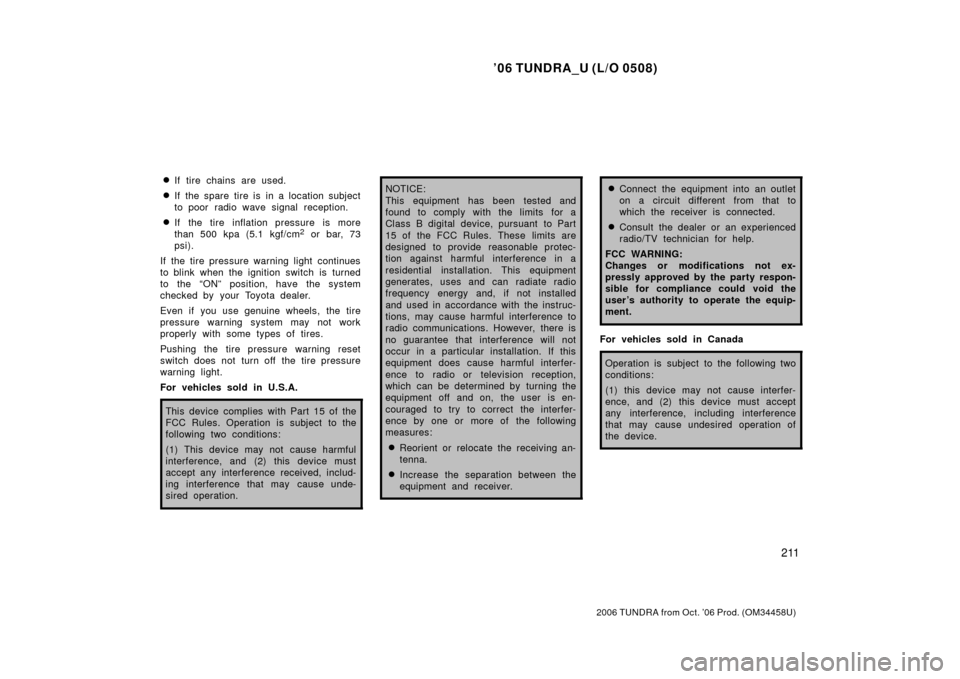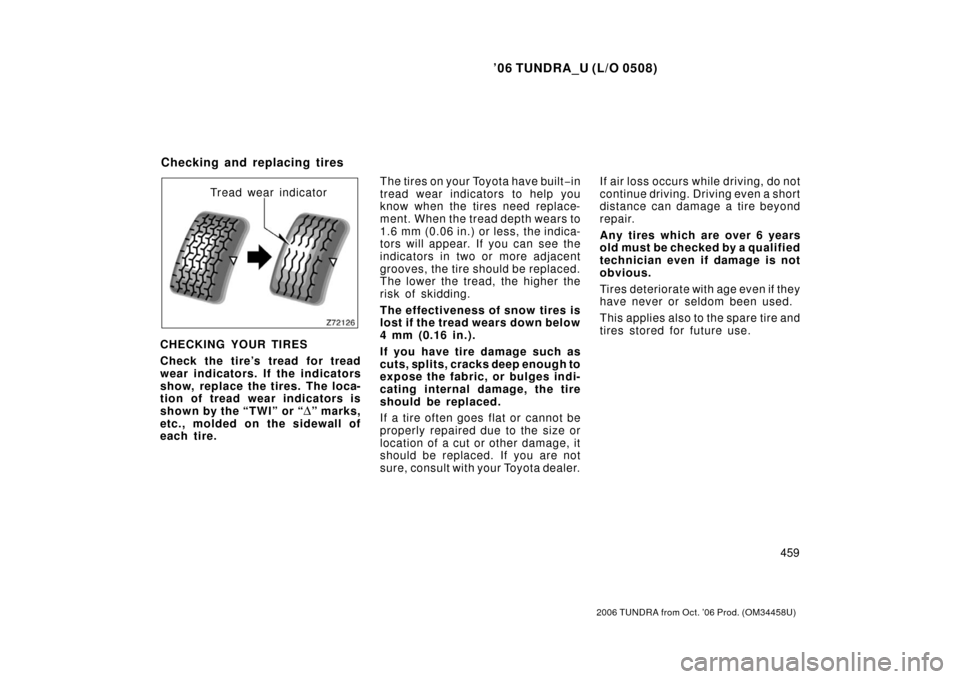Page 223 of 527

’06 TUNDRA_U (L/O 0508)
211
2006 TUNDRA from Oct. ’06 Prod. (OM 34458U)
�If tire chains are used.
�If the spare tire is in a location subject
to poor radio wave signal reception.
�If the tire inflation pressure is more
than 500 kpa (5.1 kgf/cm2 or bar, 73
psi).
If the tire pressure warning light continues
to blink when the ignition switch is turned
to the “ON” position, have the system
checked by your Toyota dealer.
Even if you use genuine wheels, the tire
pressure warning system may not work
properly with some types of tires.
Pushing the tire pressure warning reset
switch does not turn off the tire pressure
warning light.
For vehicles sold in U.S.A.
This device complies with Part 15 of the
FCC Rules. Operation is subject to the
following two conditions:
(1) This device may not cause harmful
interference, and (2) this device must
accept any interference received, includ-
ing interference that may cause unde-
sired operation.
NOTICE:
This equipment has been tested and
found to comply with the limits for a
Class B digital device, pursuant to Part
15 of the FCC Rules. These limits are
designed to provide reasonable protec-
tion against harmful interference in a
residential installation. This equipment
generates, uses and can radiate radio
frequency energy and, if not installed
and used in accordance with the instruc-
tions, may cause harmful interference to
radio communications. However, there is
no guarantee that interference will not
occur in a particular installation. If this
equipment does cause harmful interfer-
ence to radio or television reception,
which can be determined by turning the
equipment off and on, the user is en-
couraged to try to correct the interfer-
ence by one or more of the following
measures:
�Reorient or relocate the receiving an-
tenna.
�Increase the separation between the
equipment and receiver.
�Connect the equipment into an outlet
on a circuit different from that to
which the receiver is connected.
�Consult the dealer or an experienced
radio/TV technician for help.
FCC WARNING:
Changes or modifications not ex-
pressly approved by the party respon-
sible for compliance could void the
user’s authority to operate the equip-
ment.
For vehicles sold in Canada
Operation is subject to the following two
conditions:
(1) this device may not cause interfer-
ence, and (2) this device must accept
any interference, including interference
that may cause undesired operation of
the device.
Page 421 of 527
’06 TUNDRA_U (L/O 0508)
409
2006 TUNDRA from Oct. ’06 Prod. (OM 34458U)
NOTICE
Do not continue driving with a
deflated tire. Driving even a
short distance can damage a
tire and wheel beyond repair.
1. Get the required tools and
spare tire.
1 Jack handle
2 Wheel nut wrench
3Jack
To prepare yourself for an emergency,
you should familiarize yourself with
the use of the jack, each of the tools
and their storage locations.Turn the jack joint by hand.
To rem ov e: Tur n the joint in direction
1 until the jack is free.
To store: Turn the joint in direction 2
until the jack is fi rmly secured to pre-
vent it flying forward during a collision
or sudden braking.
—Required tools and spare tire
(standard cab models)
Page 422 of 527
’06 TUNDRA_U (L/O 0508)
410
2006 TUNDRA from Oct. ’06 Prod. (OM 34458U)
To remove the spare tire:
1. Insert the end of the jack handle into the lowering screw and turn
it counterclockwise.
2. After the tire is lowered completely to the ground, remove the holding
bracket.
When storing the spare tire, put it in
place with the outer side of the wheel
facing up. Then secure the tire, taking
care that the tire goes straight up
without catching on any other part, to
prevent it from flying forward during
a collision or sudden braking.
Front
Access cab models
Front
Double cab models 1. Get the required tools and
spare tire.
1 Tool bag
2Jack
To prepare yourself for an emergency,
you should familiarize yourself with
the use of the jack, each of the tools
and their storage locations.
—Required tools and spare tire
(access and d ouble cab
models)
Page 431 of 527

’06 TUNDRA_U (L/O 0508)
419
2006 TUNDRA from Oct. ’06 Prod. (OM 34458U)
CAUTION
�Take due care in handling the
ornament to avoid unexpected
personal injury.
� Do not attach a heavily dam-
aged plastic wheel ornament.
It may fly off the wheel and
cause accidents while the ve-
hicle is moving.
11. Check the air pressure of the re-
placed tire.
Adjust the air pressu re to the specifi-
cation designated in Section 8. If the
pressure is lower, drive slowly to the
nearest service station and fill to the
correct pressure.
Do not forget to reinstall the tire infla-
tion valve cap as dirt and moisture
could get into th e valve core and
possibly cause air leakage. If the cap
is missing, have a new one put on as
soon as possible.
12.Restow all the tools, jack and flat tire securely.
With a spare tire of the same wheel
type as the installed tires—
As soon after changing wheels as
possible, tighten the wheel nuts to the
torque specified in Section 8 with a
torque wrench. Have a technician re-
pair the flat tire.
With a spare tire of different wheel
type from the installed tires— As soon after changing wheels as
possible, tighten the wheel nuts to the
torque specified in Section 8 with a
torque wrench. Have a technician re-
pair the flat tire and replace the spare
tire with it.
CAUTION
Before driving, make sure all the
tools, jack and flat tire are se-
curely in place in their storage
location to reduce the possibility
of personal injury during a colli-
sion or sudden braking.
Initial adjustment of the tire pres-
sure warning system is necessary
after you have rotated your tires.
See “Tire pressure warning sys-
tem” in Section 1�7.
—After changing wheels
Page 471 of 527

’06 TUNDRA_U (L/O 0508)
459
2006 TUNDRA from Oct. ’06 Prod. (OM 34458U)
Tread wear indicator
CHECKING YOUR TIRES
Check the tire’s tread for tread
wear indicators. If the indicators
show, replace the tires. The loca-
tion of tread wear indicators is
shown by the “TWI” or “
Δ” marks,
etc., molded on the sidewall of
each tire. The tires on your Toyota have built
−in
tread wear indicators to help you
know when the tires need replace-
ment. When the tread depth wears to
1.6 mm (0.06 in.) or less, the indica-
tors will appear. If you can see the
indicators in two or more adjacent
grooves, the tire should be replaced.
The lower the tread, the higher the
risk of skidding.
The effectiveness of snow tires is
lost if the tread wears down below
4 mm (0.16 in.).
If you have tire damage such as
cuts, splits, cracks deep e nough to
expose the fabric, or bulges indi-
cating internal damage, the tire
should be repl aced.
If a tire often goes flat or cannot be
properly repaired due to the size or
location of a cut or other damage, it
should be replaced. If you are not
sure, consult with your Toyota dealer. If air loss occurs while driving, do not
continue driving. Driving even a short
distance can damage a tire beyond
repair.
An y ti res wh i ch are over 6 years
old must be checked by a qualified
technician even if damage is not
obvious.
Tires deteriorate with age even if they
have never or seldom been used.
This applies also to the spare tire and
tires stored for future use.
Checking and replacing tires